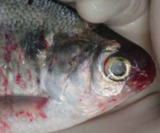- Dactylogyrus vastator
-
Dactylogyrus vastator Scientific classification Kingdom: Animalia Phylum: Platyhelminthes Class: Monogenea Order: Monopisthocotylea Genus: Dactylogyrus Species: D. vastator Binomial name Dactylogyrus vastator Dactylogyrus vastator is a hermaphroditic Flatworm of class Monogenea which has been found to be an ectoparasite of fish. This flatworm is known to inhabit the gills of the fish and has cause problems with many fish farms. However, they remain mostly non-hazardous to humans.
Contents
Physical Characteristic
Worms of the species D. vastator are a little more than 1.25 millimeters long. They have two pairs of hooks known as hamuli. A set on the bottom surface of the worm is smaller than the set at the rear. These worms have three pairs of sticky sacs and four eyespots.[1]
Distribution Range
D. vastator lives in the northern parts of North America, Europe, and Asia.
Significance to Humans
Causes mass mortality among fingerling carp in fish-rearing ponds. Abnormal multiplication of cells in the gill epithelium interferes with carp's respiratory function. The parasite is especially significant in the former Soviet Union and eastern, northern Europe,[2] and India (Specifically Sri Lanka) where carp are bred for food.[3]
Life cycle
Dactylogyrus vastator has a life cycle with only 1 host, there are no intermediate hosts. New hosts are located and infected by free-living larvae (oncomiracidium). D. vastator lives in the gills of carp and goldfish. Adults on the gill filaments lay unembryonated eggs that are washed out of the host's gill cavity and sink to the bottom of the water. Ciliated oncomiracidium emerges in 3–5 days, depending on water temperature. Under summer temperatures, development of the embryo is rapid, and fully formed oncomiracidia appear in 2½ days. The larva presses from inside the egg and forces off one end of the egg shell, leaving the embryonic membrane inside when it escapes. Larvae are drawn into the gill cavity by the water current and attach themselves to another host's gills with their hooks. Larvae can also swim about actively and attach to the skin of the carp when it comes in contact with them. Having attached to the first host, they migrate over the body toward the gills, being attracted by the mucus from them. Sexual maturity is attained about 10 days after reaching the gills.[4]
The peak of infestation on the fish is reached about the middle of July, after which the worms begin to disappear, being gone by fall. During the last phase of oviposition, winter eggs are laid; these remain in a resting stage (state of diapause, or period of inactivity) during the cold weather. With the arrival of spring and the warming of the water, development of the eggs begins and hatching soon takes place. Young carp especially are infested, often fatally when large numbers of worms are present on the gill filaments. Eggs laid during the summer hatch after a short period of incubation, resulting in an abundance of oncomiracidia with superinfection of the fish. Under these conditions, an immunity develops in the carp that reduces the infestation for about 2 months.
References
- ^ Monogeneans: Monogenea - No Common Name (dactylogyrus Vastator): Species Accounts
- ^ http://www.answers.com/topic/dactylogyrus-vastator
- ^ Thilakaratne I D S I P, Rajapaksha G, Hewakopara A, et al. (2003). "Parasitic infections in freshwater ornamental fish in Sri Lanka". Dis Aquat Org 54 (2): 157–62. doi:10.3354/dao054157. PMID 12747641.
- ^ Animal Parasites Their Life Cycles and Ecology
Pathogens - Aeromonas salmonicida
- Columnaris
- Enteric redmouth
- Fin rot
- Fish dropsy
- Flavobacterium
- Hematopoietic necrosis
- Heterosigma akashiwo
- Hole in the head
- Hypodermal and hematopoietic necrosis
- Infectious pancreatic necrosis
- Koi herpes virus
- Novirhabdovirus
- Pfiesteria piscicida
- Photobacterium damselae ssp piscicida
- Salmon anemia
- Streptococcus iniae
- Taura syndrome
- UDN
- VHS
- White spot
- Yellowhead

Parasites - Abergasilus
- Amoebic gill disease
- Carp lice
- Ceratomyxa shasta
- Dactylogyrus vastator
- Diphyllobothrium
- Epizootic ulcerative syndrome
- Flukes
- Glugea
- Gyrodactylus salaris
- Henneguya zschokkei
- Ich (freshwater)
- Ich (marine)
- Kudoa thyrsites
- Lernaeocera branchialis
- Myxobolus cerebralis
- Nanophyetus salmincola
- Salmon lice
- Saprolegnia
- Schistocephalus solidus
- Sea louse
- Sphaerothecum destruens
- Swim bladder disease
- Tetracapsuloides bryosalmonae
- Velvet
Related topics Categories:- Parasitic animals
- Fish diseases
- Monogenoidea
Wikimedia Foundation. 2010.
